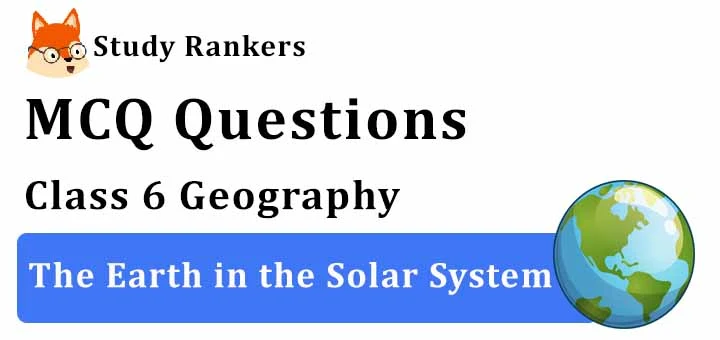MCQ Questions for Class 6 Geography: Ch 1 The Earth in the Solar System

1. Which of the following is a natural satellite?
(a) IRSA
(b) EDUSAT
(c) Moon
(d) INSAT-I
► (c) Moon
2. Asteroids are found between the orbit of______
(a) Mars and Venus
(b) Mars and Mercury
(c) Mars and Saturn
(d) Mars and Jupiter
► (d) Mars and Jupiter
3. ____ is the closest celestial body to our earth.
(a) Earth
(b) Galaxy
(c) Moon
(d) Planet
► (c) Moon
4. What is the largest Planet in the Solar System?
(a) Venus
(b) Mercury
(c) Earth
(d) Jupiter
► (d) Jupiter
5. Why is the earth called as Blue Planet?
(a) Air colour is blue
(b) Land colour is blue
(c) Building having blue colour
(d) Two-third surface is covered by water
► (d) Two-third surface is covered by water
6. Stars appear to move from
(a) West to east
(b) East to west
(c) North to south
(d) South to west
► (b) East to west
7. All the planets move around the sun in an _________
(a) Rectangular path
(b) Straight path
(c) Elliptical path
(d) Circular path
► (c) Elliptical path
8. A huge system of stars is called _______
(a) Moon
(b) Earth
(c) Galaxy
(d) Planet
► (c) Galaxy
9. Which is the nearest star to the earth
(a) Mercury
(b) Moon
(c) Venus
(d) Sun
► (d) Sun
10. How many days does it take the earth to revolve around the sun?
(a) 120
(b) 365 (1/4)
(c) 20
(d) 541
► (b) 365 (1/4)
11. Which is the brightest planet in the universe?
(a) Mercury
(b) Venus
(c) Earth
(d) Saturn
► (b) Venus
12. The polar star indicates to which direction?
(a) North
(b) East
(c) South
(d) West
► (a) North
13. Which is the closest planet to the Sun
(a) Earth
(b) Venus
(c) Mars
(d) Mercury
► (d) Mercury
14. The planet known as the Earth twin is________
(a) Mars
(b) Saturn
(c) Venus
(d) Mercury
► (c) Venus
15. Which star is the head of the solar system
(a) Earth
(b) Moon
(c) Sun
(d) Big bear
► (c) Sun
16. How many planets are there in our solar system?
(a) Five
(b) Eight
(c) Six
(d) Nine
► (b) Eight
17. Moon appears big because
(a) It is very big than the earth
(b) It is bigger than the sun
(c) It is near to the earth
(d) It is far away from the earth
► (c) It is near to the earth
18. The three quarters of Sun is made up of
(a) Methane
(b) Magnesium
(c) Hydrogen
(d) Water
► (c) Hydrogen
19. The Stars are not visible during the day because
(a) Of their self illumination
(b) Stars are far away from the earth
(c) Sun light is very bright
(d) Their size is large
► (c) Sun light is very bright
20. Which of the following planets has a reddish appearance?
(a) Mars
(b) Venus
(c) Saturn
(d) Mercury
► (a) Mars
21. What is the orbital period of the Moon?
(a) 25 days
(b) 27.32 days
(c) 28 days
(d) 29 days
► (b) 27.32 days
22. A group of _______ forming various patterns is called constellation
(a) Stars
(b) Earth
(c) Planet
(d) Moon
► (a) Stars
23. How does the moon shine
(a) Have their own natural light
(b) Reflects the Venus light
(c) Reflects the earth light
(d) Reflects the sunlight
► (d) Reflects the sunlight
24. The Planets don’t have __________ of their own.
(a) Heat and Water
(b) Oxygen and Water
(c) Water and light
(d) Heat and light
► (d) Heat and light

